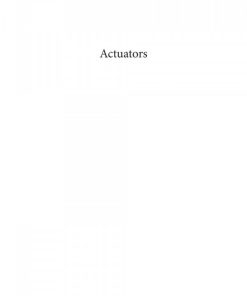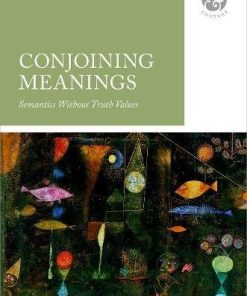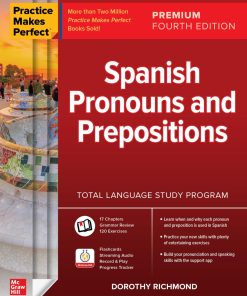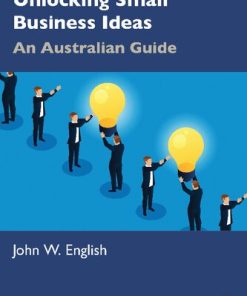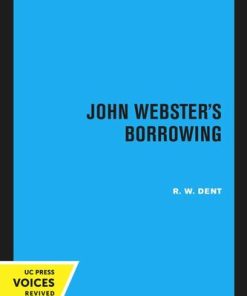English Prepositions Their Meanings and Uses 1st edition by Dixon 0192639293 9780192639295
$50.00 Original price was: $50.00.$25.00Current price is: $25.00.
English Prepositions: Their Meanings and Uses 1st edition by R. M. W. Dixon – Ebook PDF Instant Download/DeliveryISBN: 0192639293, 9780192639295
Full download English Prepositions: Their Meanings and Uses 1st edition after payment.
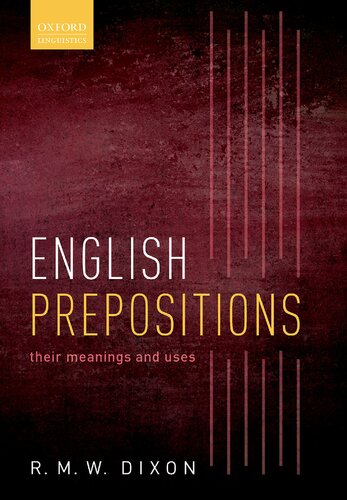
Product details:
ISBN-10 : 0192639293
ISBN-13 : 9780192639295
Author : R. M. W. Dixon
This book provides an integrated account of the main prepositions of English, outlining their various forms and illustrating contrastive senses. The three chapters in Part I delineate grammatical contexts of occurrence and special uses, exploring grammatical roles, phrasal verbs, and prepositional verbs respectively. In Part II, each chapter deals with a set of related prepositions, providing an integrated account of the meanings for each, and explaining how these are linked to their grammatical properties. There are two chapters on relational prepositions – principally of, for, by, and with – which have only minor reference to space or time. These are followed by seven chapters on prepositions whose basic meaning is spatial, with many extensions to abstract senses, and one that ties together the varied ways through which prepositions deal with time. The final chapter outlines how some people have attempted to prescribe how language should be used; it also covers dialect variation, foreign learners’ errors, and prospects for the future. The book is written in Dixon’s accustomed style – clear and well-organized, with easy-to-understand explanations, and with limited use of technical terms. The book will be of interest to students and scholars of the English language, including instructors of English as a second language.
English Prepositions: Their Meanings and Uses 1st Table of contents:
1: A story to tell
1.1 Selected contrasts
1.1a To and at
1.1b Of and about
1.1c In and out-of
1.2 Meanings
1.3 Phrasal verbs
1.4 Prepositional verbs
1.5 Pairings—major and minor members
1.6 Realisation as clitics
1.7 Prepositions and adverbs
1.8 Further functions
1.9 Related prefixes
1.10 Endings -s and -st
Part I: The Stage is Set
2: Grammatical roles
2.1 Inner and outer peripheral noun phrases
2.1a Inner peripheral noun phrases
2.1b Omission of the noun phrase from an inner peripheral noun phrase
2.1c Left movement of preposition or adverb over a preceding noun phrase
2.1d Outer peripheral noun phrases
2.2 Preposition stranding
2.3 Complex prepositions
2.4 Other roles for a peripheral noun phrase
2.4a With a noun
2.4b As copula complement
2.4c With an adjective
2.5 Manipulating prepositions
2.5a Inserting a preposition
2.5b Omitting a preposition
2.5c Preposition dropping before a complementiser
2.6 Modifying a preposition
2.7 Prepositions which may follow their noun phrase
3: Phrasal verbs
3.1 Examining meanings
3.2 Two kinds of phrasal verb
3.3 The six types of phrasal verb
3.4 Transitivity
3.5 Left movement
3.6 Maintaining the integrity of a phrasal verb
3.7 The prepositions and adverbs involved
4: Prepositional verbs
4.1 Properties
4.1a Maintaining adjacency
4.1b Complement clause in object function
4.1c Nominalisations
4.1d Omitting preposition plus noun phrase
4.1e Two prepositional verbs involving the same simple verb
4.2 Meanings
4.2a Dispose of and discard
4.2b Object to, disapprove of, and dislike
4.2c Decide on and choose
4.2d Aspire to and seek
4.2e Grapple with, struggle, and fight
4.2f Allude to and mention
4.3 Analysis
4.4 Hard to place
Part II: The Players
5: The mainstays: Of, for
5.1 Contrastive uses
5.2 Of
5.2a Possession (in a wide sense)
5.2a-1 Ownership
5.2a-2 Creatorship
5.2a-3Association
5.2a-4 Material part
5.2a-5 Attribute
5.2a-6 Object nominalisations
5.2a-7 Contrasting of and ’s
5.2b Expansion
5.2c Quantifying
5.2d Relationship
5.2e Focusing on a quality
5.2f Feelings, attitude, or competence
5.2f-1 The issue arouses feelings in the subject
5.2f-2 The subject has a certain property with respect to the issue
5.2f-3 The subject has feelings (or an attitude) towards the issue
5.2f-4 The subject has a specialised competence with respect to the issue
5.2g Knowledge
5.2h Dissociation
5.2i Special constructions with of
5.2j Of repeated
5.2k Optional of
5.2l Other uses
5.3 For
5.3a Benefit
5.3b Reason
5.3b-1 The reason for the subject’s mental attitude
5.3b-2 The reason for the subject’s attitude towards someone
5.3b-3 The reason for the subject having a certain quality
5.3b-4 The reason for the subject undertaking some activity:
5.3b-5 The reason why the referent of an abstract noun is needed:
5.3b-6 The reason for a certain quality being ascribed to the subject:
5.3c Purpose
5.3c-1 Ability to achieve a purpose
5.3c-2 Attention directed towards a goal
5.3c-3 An action directed towards a goal
5.3c-4 A potentiality of the referent of a noun
5.3c-5 Destination
5.3c-6 Mental aspiration
5.3d As complementiser
5.3e Exchange
5.3f Time (and space)
5.3g Special constructions with for
5.3g-1 Comparison with a norm
5.3g-2 Mistaken identity
5.3h For in phrasal verbs and prepositional verbs
5.3i Combining instances of for
5.3j Other uses
5.3j-1 In phrasal prepositions
5.3j-2 As a conjunction
5.4 Prepositions used in New Zealand ministerial titles
5.4a Nations using for
5.4b Nations using of
5.4c New Zealand
5.5 Comparing the two prepositions of and for
6: Supporting artists: By, with, together, together-with, except(-for), but(-for), despite, in‑spi
6.1 By
6.1a ‘Near to, not quite reaching’
6.1b How something is done
6.1b-1 How something moves
6.1b-2 How something is organised physically
6.1b-3 The increments by which something progresses
6.1b-4 How some activity is conducted
6.1b-5 How a mental condition or state is achieved
6.1b-6 How some knowledge or skill is obtained
6.1b-7 The reason for an attribute
6.1c By as marker of the erstwhile agent in a passive construction
6.1d By in phrasal verbs
6.2 With
6.2a The means by which something is achieved
6.2a-1 An instrument in a physical action
6.2a-2 Something abstract as the means to achieve a social ambience or a mental state
6.2a-3 How a phase of an activity is conducted
6.2b Association
6.2b-1 An inherent feature
6.2b-2 Knowledge
6.2b-3 External features
6.2b-4 Association with a person (or animal)
6.2b-5 Social interaction
6.2b-6 Physical interaction
6.2b-7 Severing an association
6.2b-8 Temporal association
6.2c Agreement
6.2d Explanation for a state
6.2d-1 Physical state
6.2d-2 Mental state
6.2e Activity directed towards something
6.2f With in phrasal verbs and prepositional verbs
6.2g Further points of interest
6.2g-1 Without
6.2g-2 More than one with phrase
6.2g-3 Initial elements
6.2h Contrasting by and with
6.3 Together and together-with
6.4 Except (-for) and but (-for)
6.5 Despite and in-spite-of
7: The central spatial prepositions: At, to, toward(s), from
7.1 At
7.1a Focus on a spatial position
7.1b Focus on a temporal point, and on speed
7.1c Focus on a target
7.1c-1 Movement with respect to a target
7.1c-2 Action with respect to a target
7.1c-3 Focus of speaking
7.1c-4 Focus of looking and of facial or other gesture
7.1d Focus of an emotion
7.1e Focus of an ability
7.1f Focus on quantity
7.1g Several occurrences in a sentence
7.1h Contrasting at with other prepositions
7.1h-1 Of and at
7.1h-2 For and at
7.1h-3 By and at
7.1h-4 With and at
7.2 To
7.2a Basic meanings
7.2a-1 Motion with respect to a destination
7.2a-2 Contiguity
7.2a-3 Attachment
7.2a-4 Change
7.2a-5 Directing attention to the nature of something
7.2b Similarity
7.2c Beneficiary
7.2c-1 The transitive object has non-human reference
7.2c-2 The transitive object has human reference
7.2c-3 An intransitive verb where the to phrase has human reference
7.2d Attitude
7.2e Mode
7.2f Interaction
7.2g Relevance
7.2h Potentiality and phase
7.2i To in phrasal verbs and prepositional verbs
7.2j Other uses of to
7.2k Contrasting to with other prepositions
7.2k-1 Of and to
7.2k-2 For and to
7.2k-3 By and to
7.2k-4 With and to
7.2k-5 At and to
7.3 Towards and toward
7.3a Spatial meaning
7.3b Temporal meaning
7.3c In the direction of an achievement
7.3d Feelings directed at someone or something
7.3e Attitude directed at some act or state (but not quite getting there)
7.4 From
7.4a Basic meanings
7.4a-1 Motion with respect to an origin
7.4a-2 Distance
7.4a-3 Change
7.4b Source
7.4c Absence
7.4c-1 Missing
7.4c-2 Eviction
7.4c-3 Separation
7.4c-4 Extraction
7.4c-5 Subtraction
7.4d Difference
7.4e Prevention and lack of involvement
7.4e-1 Prevention
7.4e-2 Lack of involvement
7.4f Contrasting from with other prepositions
7.4f-1 Of and from
7.4f-2 By and from
8: Enclosure: In, into, out, out-of; within, without, inside(-of ), outside(-of )
8.1 In and into
8.1a Basic meanings
8.1b Time and speed
8.1c A human in a certain state
8.1c-1 Immersed in a physical state
8.1c-2 Enveloped in a mental or emotional attitude
8.1c-3 Displaying an attitude or an aptitude
8.1c-4 Engaged in an activity
8.1d Part of a group
8.1e In a certain form or condition
8.1f Engendering a happening
8.1g A specific property within a general field
8.1h Adverbial modifiers
8.1i In and into in phrasal verbs and prepositional verbs
8.1j Contrasting in and into with other prepositions
8.1j-1 Of and in
8.1j-2 By and in
8.1j-3 With and in
8.1j-4 At and in
8.1j-5 At and into
8.1j-6 To and in
8.2 Out-ofand out
8.2a Lacking
8.2b Arising from
8.2c Adverb function
8.2c-1 Direction
8.2c-2 Release
8.2c-3 Done fully
8.2d Out and out-ofin phrasal verbs
8.2e Contrasting from and out-of
8.3 Within and without, inside(-of) and outside(-of)
8.3a Within and inside(-of)
8.3a-1Three opposites for within
8.3b Outside(-of)
9: Connection and adjacency: On, upon, onto, off, off-of; against; beside(s)
9.1 On, upon, and onto
9.1a Basic meanings
9.1a-1 Physical connection
9.1a-2 Activated connection
9.1a-3 Detached connection
9.1b Prolongation
9.1c Mental links
9.1c-1 Mental activity
9.1c-2 Mental attitude
9.1c-3 Manner, outlook, and stance
9.1d State
9.1e Dependence
9.1e-1 General dependency
9.1e-2 Material dependency
9.1f Quantitative
9.1g Temporal
9.1h On, upon, and onto in phrasal verbs and prepositional verbs
9.1i Contrasting on and upon with other prepositions
9.1i-1 Of and on
9.1i-2 For and on
9.1i-3 By and on
9.1i-4 At, in, and on
9.1i-5 At and on
9.1i-6 To and on
9.1i-7 Towards and (up)on
9.1i-8 In and on
9.1i-9 Into and (up)on
9.2 Off and off-of
9.2a Removal and deprivation
9.2b Off-of
9.2c Off in phrasal verbs and prepositional verbs
9.2d Contrasting off with other prepositions
9.2d-1 From, out-of,and off
9.2d-2 Out and off
9.3 Against
9.3a Opposition
9.3a-1 Involving social acts
9.3a-2 Contrary acts
9.3b Contrast
9.3c Balance
9.3d Against in phrasal verbs
9.3e Contrasting against with other prepositions
9.3e-1 With and against
9.3e-2 From and against
9.3e-3 On and against
9.4 Beside(s)
9.4a Basic meaning
9.4b Addition
9.4c Contrasting by with beside
10: Superiority: Up, up-to,down
10.1 Up
10.1a Superior position
10.1a-1 Spatial
10.1a-2 Value
10.1a-3 Intensity
10.1b Maintenance
10.1c Creation
10.1d Completion
10.1e Cessation
10.1f Up in phrasal verbs
10.1g Contrasting up with other prepositions and adverbs
10.1g-1 In and up
10.1g-2 By and up
10.2 Up-to
10.2a Superior position, value, or time
10.2b Maintenance
10.2c Creation
10.3 Down
10.3a Inferior position
10.3b Personal feelings
10.3c Finishing
10.3d Down in phrasal verbs
10.3e Contrasting up and down; plus off and out
11: Position: Over, under, above, below, beneath, underneath; behind, ahead(-of ), in-front(-of), ba
11.1 Vertical position: Over, under, above, below, beneath, underneath
11.1a Over and under
11.1a-1 X extends from one side to the other of Y
11.1a-2 X moves from one side to the other of Y
11.1a-3 X is on the far side of Y
11.1a-4 Under in hiding
11.1a-5 Over and under in prepositional verbs and phrasal verbs
11.1a-6 Contesting over with other prepositions
11.1a-6a Of and over
11.1a-6b For and over
11.1a-6c On and over
11.1a-6d Against and over
11.1b Above and below
11.1c Beneath and underneath
11.2 Horizontal position and orientation: Behind, ahead(-of), in-front(-of), back, forth, forward(s)
11.2a Behind
11.2a-1 Beneath and behind converging
11.2b Ahead(-of)
11.2c In-front(-of) and back
11.2d Forth
11.2e Forward(s) and backward(s)
11.3 Distance: Beyond, near(-to), close-to,far-from
11.3a Beyond
11.3b Near(-to), close-to,far-from
11.4 Passage: Along, alongside, across, through, throughout
11.4a Along
11.4a-1 Alongside
11.4b Across
11.4c Through
11.4c-1 Three-dimensional space
11.4c-2 A gap
11.4c-3 Completion
11.4c-4 Through an intermediary
11.4c-5 By reason of
11.4c-6 Through in phrasal verbs
11.4c-7 Contrasting through with other prepositions
11.4c-7a By and through
11.4c-7b Over and through
11.4c-7c Above and through
11.4d Throughout
12: Distribution: Among(st), amid(st), between, in-between; (a)round; about, concerning
12.1 Among(st), amid(st), between, in-between
12.1a Among(st)
12.1a-1 Contrasting with and among(st)
12.1b Amid(st)The NP following amid
12.1c Between and in-between
12.1c-1 Spatial or temporal separation
12.1c-2 The complex preposition in-between
12.1c-3 Joining across a gap
12.1c-4 Creation of a gap
12.1c-5 Division
12.1c-6 Choice
12.2 (A)round
12.2a (A)round in phrasal verbs
12.2b Contrasting over and (a)round
12.3 About, concerning
12.3a Basic senses
12.3b About and concerning
12.3c About and other prepositions
12.3d About in prepositional verbs and phrasal verbs
13: Separation: Apart(-from), aside(-from), away(-from)
13.1 Apart(-from)
13.1a Preposition apart-from
13.2 Aside(-from)
13.2a Preposition aside-from
13.3 Away(-from)
13.3a Distance
13.3b Disposal
13.3c Diminution
13.3d Commencement and continuation
13.3e Away in a prepositional verb and in phrasal verbs
13.3f Contrasting off and away(-from)
14: Temporal: Since, because(-of ); until/till, up-until/up-till;during; after, afterward(s), before
14.1 Since, because(-of)
14.1a Temporal sense of preposition since
14.1b ‘Consequence’ sense of conjunction since
14.1c ‘Reason’ sense of conjunction because and preposition because-of
14.2 Until/till, up-until/up-till
14.3 During
14.4 After, afterward(s), before, beforehand
14.4a Temporal sense
14.4b Spatial sense
14.4c Further senses of after
14.4d After in phrasal verbs
14.4e Contrasting after with other prepositions
14.4e-1 For, about, and after
14.4e-2 For and after
14.4e-3 Behind and after
14.5 Past
14.6 The mechanisms of time description
14.6a Time designation
14.6b Relative time
14.6c Deferred time
14.6d A time span
14.6e Composition of a time span
14.6f A period of time
15: Do it your way
15.1 Interfering busybodies
15.2 Heads in the sand
15.2a Inside-of
15.2b In-between
15.2c Upon
15.2d Off-of
15.2e Since
15.3 Variation
15.3a Across the Atlantic
15.4 Not quite right
15.5 Moving forward
People also search for English Prepositions: Their Meanings and Uses 1st:
english prepositions explained
english prepositions and their uses
english prepositions time
all english prepositions with examples
english prepositions list
Tags: English Prepositions, Their Meanings, Uses, Dixon
You may also like…
Politics & Philosophy - Anthropology
dictionaries & phrasebooks
History - European History
Radical Parliamentarians and the English Civil War 1st Edition
Chemistry - Chemistry - General & Miscellaneous
Uncategorized




